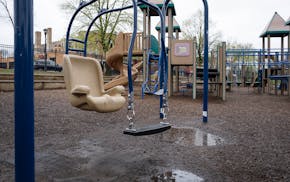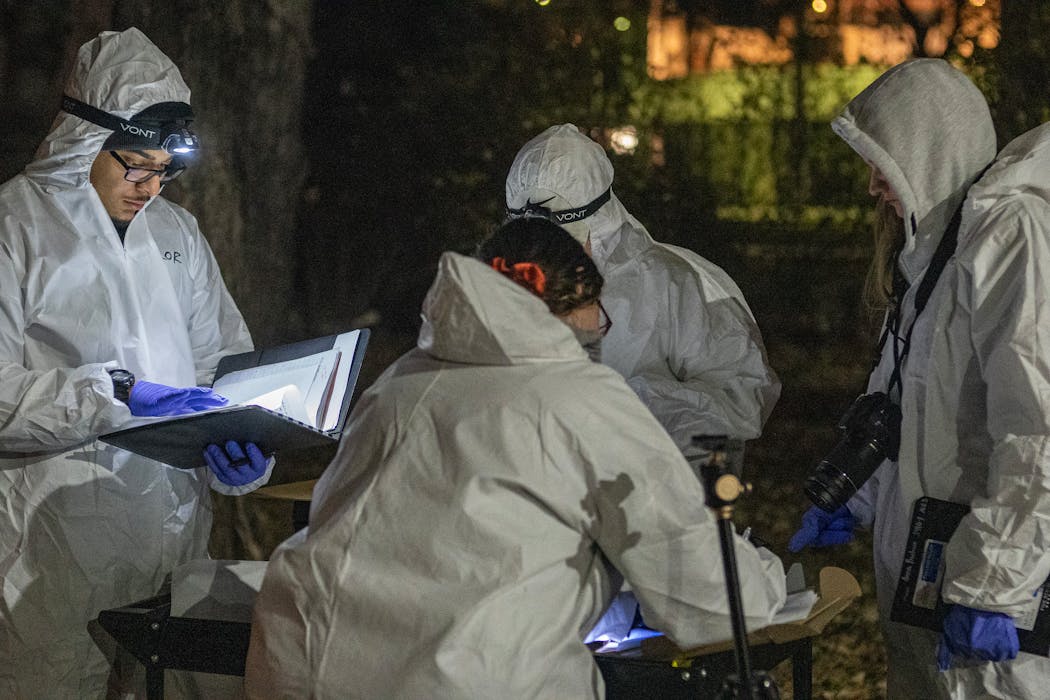The calls come after midnight: "There has been an incident in the Blue Garden. I need you to respond."
Forensic science students at Hamline University rise from their sleep and trickle into the courtyard at the center of the St. Paul campus, where a crime scene awaits.
The victims are mannequins. Their wounds are prosthetics. Now the students must collect the evidence and figure out what happened to them.
"It's really a test of everything they've learned this semester," said assistant professor Jamie Spaulding. And it's a test of whether the students really want to become forensic investigators.
Hamline is one of the few colleges in the Midwest that offers a forensic science major, which aims to prepare students for careers as investigators. While some people still enter the field after studying criminal justice, biology or chemistry, Spaulding hopes that offering a forensic science major provides students with more hands-on experience and makes their credentials more appealing to potential employers.
The university has been offering the major for just a couple of years, and already roughly 60 students have signed up for it. Another 30 students are minoring in it. Demand for forensic science technicians is expected to grow this decade, and the median wage runs about $80,000 per year, according to data from the Minnesota Department of Employment and Economic Development.
The crime scene and death investigation course is one of the most popular electives in the program, which also includes classes on lifting fingerprints, testing firearms and giving court testimony.
By the time they arrive at the courtyard crime scene, students have learned to sketch out a crime scene and photograph it. They've learned to test blood and semen. They've learned how to catalog evidence.
And Spaulding has tried to throw them a few curveballs along the way. During an earlier class, when students accidentally left a mock shooting scene unguarded, Spaulding snuck in, stole the weapon and turned over evidence markers.
"This is where they get to make mistakes," he said. "Our students can't afford to get it wrong when they leave here."
A mystery on campus
It's dark. It's drizzling. It's chilly.
Teaching assistant Indigo Rowland will play the role of a witness, a podcaster named Zoeighy Sctarr, whose statements are meant to leave students wondering who's lying and who's telling the truth.
"We have lined up a lot of challenges for them this evening," Rowland said. "You've got to be prepared for the unexpected things."
By night's end, some students' passion for forensic science will be stronger. Others might decide it's not the field for them. As they arrive at the scene, some students are groggy, having slept through the initial calls. Others appear bright-eyed and ready to dive in.
The students have been split into two teams, selected based on where they chose to sit on the first day of class. Each has its own crime to investigate.
Fran Zyla, a senior who wants to become a DNA analyst, is leading one of the teams. A woman is facedown on the ground. A man is sitting upright on a bench nearby. Both are dead.
The group starts scouring the scene, looking first for any critical evidence that could be damaged by the rain. They find a piece of paper.
They're immersed in their work when three volunteers pretending to be fraternity brothers out for a 2 a.m. stroll burst through the crime scene tape, saying they think one of the victims might be their friend. A student investigator blocks them and moves them back behind the tape, telling them it's best for their safety and to preserve the evidence.
By 3 a.m., the students are starting to form some theories: Maybe the man and the woman were a couple. Maybe she was pregnant. She appears to have been shot, while the man has several types of wounds that are inconsistent with each other.
They know they still have a long way to go. The stress is palpable, but so too is the enthusiasm. "This is like our Super Bowl," Zyla says.
'A hard lesson'
As the students work, Spaulding is taking mental notes: Could they have been more efficient? Did they overlook crucial pieces of evidence?
He'll stay until the students are confident they've gathered everything they can from the scene. He'll sleep in his office if he needs to. The students can submit evidence for testing — if they find it. They'll have five days to submit reports.
Then, he'll give them feedback on how they could improve. Maybe they should have knelt while looking for evidence instead of standing. Maybe they forgot to ask a witness a crucial question.
But he won't tell them whether they arrived at the right suspects. They won't get that reassurance in the real world.
"In the field, we're never going to know if we got it right or wrong," Spaulding said. "That's a hard lesson."
Minnesota Innocence Project seeks records in murder case that hinged on embattled medical examiner's testimony

Minnesota Power agrees to smaller bill increase for customers in settlement

Minneapolis students want better playground accessibility for classmates with disabilities

Sharon Lubinski, first openly gay U.S. Marshal and longtime MPD leader, dies at 71



